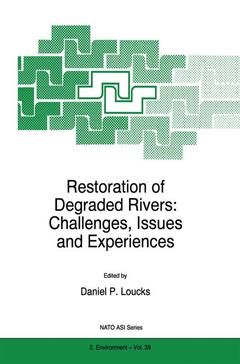Description
Restoration of Degraded Rivers: Challenges, Issues and Experiences, Softcover reprint of the original 1st ed. 1998
NATO Science Partnership Subseries: 2 Series, Vol. 39
Coordinator: Loucks D.P.
Language: English
Subjects for Restoration of Degraded Rivers: Challenges, Issues and...:
Keywords
WLAN; biodiversity; development; groundwater; modeling; object oriented design; organization; hydrogeology
Publication date: 10-2010
484 p. · 15.5x23.5 cm · Paperback
484 p. · 15.5x23.5 cm · Paperback
Description
/li>Contents
/li>Comment
/li>
In the continued quest for increased economic benefits from our water resources, numerous structures and operating policies for controlling the river flow have been built and implemented. These structures and associated operating policies can facilitate navigation; they can provide greater quantities of reliable water supplies to meet agricultural, industrial and municipal water demands; they can generate hydroelectric power and energy; and they can provide increased flood protection, recreation, and other benefits. Over the past half-century we have converted many of our rivers into engineered waterways. These straightened, often periodically dredged, engineered rivers are complete with dikes, reservoirs, weirs, and diversion canals. All this engineering has enhanced economic development. However, as rivers and their floodplains become stressed from the excessive use and misuse of their resources, their contribution to economic development can be threatened. Evidence of economic and ecological degradation, especially in relatively large river systems such as the Danube, the Mississippi, the Rhine, and the Volga, has increased our appreciation of beneficial roles natural aquatic and terrestrial ecosystems play in water quantity and quality management. We have recognized the need to pay more attention to letting nature help us regulate water quantity and quality rather than working against nature and its variabilities and uncertainties. Today there are efforts underway in many developed river basins to 'de engineer' or return these straightened and controlled rivers to a more natural state.
Preface. Part I: Overview. Restoration of Degraded Water Resource Systems: Issues, Opportunities, Challenges and Experiences; D.P. Loucks, A.B. Avakian. Restoration through Imagination in Planning and Management; W.K. Johnson. Part II: Case Studies. Ecological Problems of River Systems Regulated by Reservoirs; A.B. Avakian. A Conceptual Study on the Rehabilitation of the Lignite Mining Area South of Leipzig; J. Birkhölzer, et al. The Restoration of Degraded River Basins: A Review of the Ave River Project; J.R. Da Costa, et al. Institutional Aspects of River Basin Management in Russia: The Example of the Ob; R. Dankova. Rehabilitation of the Tagus Estuary; A.V. De Sousa. The River Acheloos' Diversion Project for Rehabilitation of Water Resources; N. Gousgounis. Hydroecological Problems of Big River Basins: Origins and Possible Solutions; N. Koronkevich. Problems of Large Scale Basins of Russia; A.N. Mikheev. Environmental Consequences of Water Resource Development in California; G.T. Orlob. River Restoration in European Lowland River Systems; B. Pedroli, J. Dijkman. Environmental Restoration of Surface and Groundwater in the Upper Tisza Basin; M. Racický, et al. United States Water Resources Experience Related to European Water Management Concerns; K.E. Schilling. Ili-Balkash Basin: The State and Prospects of Nature Management; I.V. Seversky, I.M. Malkovsky. The Development Plan of the Transboundary Euphrates-Tigris Basin and Environmental Considerations; F. Turkman. Siberian Rivers and Their Environmental Problems; O.F. Vasiliev. Water Quality and Environmental Degradation in the Tom River Basin (Western Siberia): The Need for an Integrated Management Approach; O.F. Vasiliev. Part III:Methodologies. Organization, Management and Financing of Environmental Rehabilitation Projects: Experiences in Eastern Germany; U.J.E. Arnold, K.-J. Haupt. Computer-Supported Restoration of Rivers in Germany; R. Boettcher, J. Köngeter. A Decision Support System for Planning Environmental Flow Allocations; J.R. Davis, W.J. Young. The Impact of Land Reclamation Upon the Landscapes of Large River Basins; K. Dyakonov. Guidelines for Riverine Water Quality Rehabilitation and Management During Economic Transition: Institutions, Economics and Alternative Strategies; C.W. Howe, J.J. Carmichael. Integrated Groundwater Management for Open Pit Mining Regions: The Role of Sophisticated Numerical Tools for Interactive Monitoring, Predictive Modelling and Decision-Making; D. Jansen, et al. Computer-Based Support for Planning and Negotiation on Environmental Rehabilitation of Water Resource Systems; A.V. Lotov. Water Resource Conflict Resolution Based on Interactive Tradeoffs Display; A.V. Lotov, et al. GIS-Aided Modelling of Groundwater Situations in Open Pit Mining Areas; K. Malakhanov, et al. Index.
There have been frequent, extensive efforts made over recent decades to develop and manage water resource systems to meet multiple purposes and objectives, especially for large rivers. Control of the spatial and temporal distribution of water in those rivers in order to meet more effectively a variety of economic in-stream and off-stream purposes and uses and increased point and non-point pollutant loadings has often reduced the health of the rivers' aquatic and terrestrial ecosystems, and decreased the rivers' floodplain and wetland areas. The result has been a loss in ecosystem biodiversity and reduced self-purification capacities and an increase in the magnitude of the peak flows -- and economic damage -- accompanying major floods. This book focuses on the central issue of how best to d
© 2024 LAVOISIER S.A.S.




